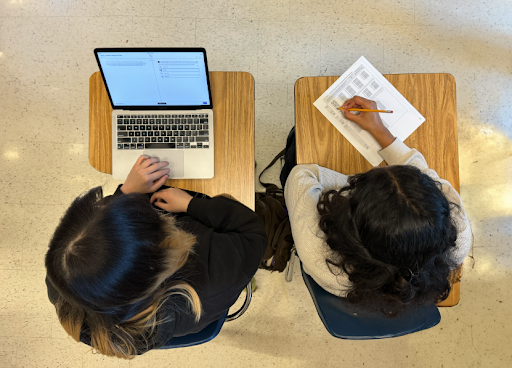Image from author
After over 95 years of being administered on paper, the final physical SAT was administered on December 2nd, 2023. It will only be given digitally starting March 2024, and it is a transition bound to be filled with road bumps. The student population is divided on this monumental shift for such a ubiquitous test.
The paper SAT is a standardized test divided into four sections: Reading, Writing & Language, and two Math sections (the second allows calculator usage). The total time allotted for the exam is 180 minutes, with 154 questions. The recently introduced Digital SAT (DSAT) has two sections, with two comprehensive Reading and Writing modules, and two calculator-allowed Math modules. This version has 56 fewer questions than the paper version, and test takers are given 134 minutes for the entire exam. However, the digital exam is adaptive–the questions in the second module of each section are dependent on the accuracy of the first.
While the DSAT may sound easier, many students prefer the physical version over the digital version due to the adaptive nature of the exam. Bhavya Mehta, a junior who’s taken the SAT twice and the Digital PSAT, said, “I don’t think the adaptive test is technically standardized–it doesn’t really exemplify the meaning of a standardized assessment.” Her belief is echoed by several students across Washington High School’s campus, with Siddharth Rajagopal, a junior, finding it much easier to prepare for the physical exam due to its standardized nature.
However, the shift to a digital SAT is being welcomed by proctors and CollegeBoard as a way to curb cheating on the exam. Mrs. Ponssen, the Career and College Specialist at Washington High School, who proctored the physical and digital PSAT, says “I think the Digital [SAT] curbs cheating. I like that about the digital version.” This is due to the test being adaptive, meaning no students will get the same questions in the same order, making it difficult for test-takers to take a peek at other multiple-choice answer sheets. Furthermore, Mrs. Ponssen likes the convenience of the digital exam and she thinks it helps some students focus better, as it is more interactive.
The shift to the DSAT raises several important questions–namely the continued relevance of a standardized test in today’s world, and the score disparity between higher and lower-income students. The test’s effectiveness as a measure of a student’s capabilities is a matter of constant debate. Nearly 60% of students polled believe the SAT should not be taken–partly due to Washington’s proximity to the University of California and California State University systems, which do not review standardized test scores during the admissions process. Ian Han, a junior, put it simply: “if you don’t plan on applying to private schools, it’s irrelevant.” As a result, many students don’t feel inclined to take the SAT and instead focus on extracurriculars and grades. Mukul Dangi, a senior currently going through the college admissions process, agrees with this notion, saying, “4 years of courses offers a greater sample size for assessment when compared to a singular 3-hour-long assessment.”
A major difference in scores between higher and lower income students is raising concerns about the viability of the test as a measure of intelligence. Higher-income students are able to afford expensive SAT tutoring, with Elite Education’s SAT Prep packages costing upwards of $3000. A Harvard-based research institute found it 13 times more likely for children of the top 1% to score higher than 1300 on the SAT. Yet some students believe that the exam allows for a better view of the student, with junior Parth Doshi saying, “The SAT is needed to bridge differences in grading, grade scales, and overall school rigor during college applications.”
The efficacy of the SAT will always be debated, but one thing is certain: the shift to a Digital SAT will usher in a new age of test-taking and open dialogue on how to make the test into a more just and equitable experience for all test-takers.
Atharva Sonune, currently in his Junior Year, has had a diverse upbringing that spans India, Ohio, and California. Embarking on his inaugural year at the paper, Atharva brings a fervent curiosity for journalism. His passions encompass a wide array of topics, including emerging technology, economics, and politics. Beyond the world of writing, Atharva actively engages as a dedicated DECA member, is interested in guitar, and loves to edit videos. He wishes to hone his photography skills and is currently focusing on getting ready for college applications next year.



nice
nice